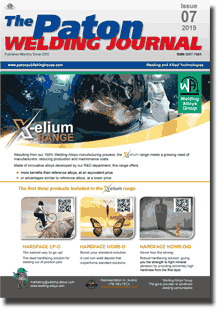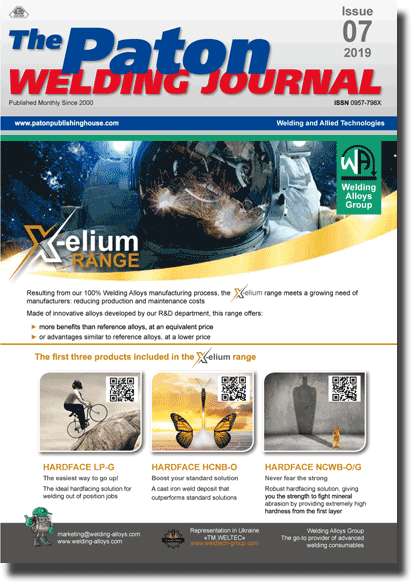| 2019 №07 (05) |
DOI of Article 10.15407/tpwj2019.07.06 |
2019 №07 (07) |

The Paton Welding Journal, 2019, #7, 25-28 pages
Journal The Paton Welding Journal
Publisher International Association «Welding»
ISSN 0957-798X (print)
Issue #7, 2019 (July)
Pages 25-28
Influence of the composition of electrode coating binder on toxicity of welding fumes
O.G. Levchenko1, A.O. Lukyanenko2 and O.V. Demetskaya3
1National Technical University of Ukraine «Igor Sikorsky KPI» 37 Pobedy Ave., 03056, Kyiv, Ukraine. E-mail: levchenko.opcb@ukr.net
2E.O. Paton Electric Welding Institute of the NAS of Ukraine 11 Kazimir Malevich Str., 03150, Kyiv, Ukraine. E-mail: office@paton.kiev.ua
3Kyiv International University 49 Lvivska Str., 03179, Kyiv, Ukraine
Results of sanitary-hygienic evaluation of coated electrodes for welding high-alloyed chromium-nickel steels were used to study the influence of the composition of electrode coating binder on the toxicity of fumes, which form at application of these electrodes. Express-method of determination of cytotoxicity, levels of evolution and chemical composition of welding fumes, as well as their calculated hygienic indices in accordance with international standard DSTU ISO 15011-4:2008 were applied for this purpose. It is shown that in order to develop new grades of welding electrodes with improved hygienic characteristics, it is reasonable to have not only the data of primary sanitary-hygienic evaluation, but also the results of biological studies of the toxicity of welding fumes. It is found that application in electrode coating of a binder based on pure lithium or lithium-sodium-potassium liquid glass instead of potassium-sodium one, enables reducing the level of welding fume evolution into the air, its content of highly toxic hexavalent chromium, and lowering its general toxicity due to that. 14 Ref., 3 Tables, 4 Figures.
Keywords: coated electrodes, welding fumes, hexavalent chromium, cytotoxicity index
Received: 22.01.19
Published: 24.07.19
References
1. Levchenko, O.G. (2015) Welding aerosols and gases: Processes of formation, methods of neutralization and security protection means. Kiev, Naukova Dumka [in Russian].2. (2011) DSTU ISO 15011-1:2008: Occupational health and safety in welding and allied processes. Laboratory method of aerosol and gas extraction formed in arc welding. Pt 1: Determination of emission level and sampling for analysis of aerosol microparticles. Valid from 2008-8-15. Kyiv: Derzhspozhyvstandart Ukrainy [in Ukrainian].
3. (2011) DSTU ISO 15011-1:2008: Occupational health and safety in welding and allied processes. Laboratory method of aerosol and gas extraction. Pt 4: Fume data sheets. Valid from 2008-8-15. Kyiv: Derzhspozhyvstandart Ukrainy [in Ukrainian].
4. Kundiev, Yu.I., Korda, M.M., Kashuba, M.O., Demetska, O.V. (2015) Toxicology of fumes. Ternopil, TDMU Ukrmedknyga [in Ukrainian].
5. Demetska, O.V., Leonenko, N.S., Movchan, V.O. et al. (2016) Method of express-evaluation of toxicity of welding fumes in vitro. Pat. 110801, Ukraine, Int. Cl. G 01 N 33/48 (2006/01) [in Ukrainian].
6. Levchenko, O.G., Demetska, O.V., Lukyanenko, A.O. (2016) Cytotoxicity of welding fumes formed in arc welding with coated electrodes. Ukrainsky Zh. z Problem Medytsyny Pratsi, 48(3), 30-36 [in Ukrainian].
7. Yushchenko, K.A., Bulat, A.V., Levchenko, O.G. et al. (2009) Effect of composition of base metal and electrode covering on hygienic properties of welding fumes. The Paton Welding J., 7, 44-48.
8. Yushchenko, K.A., Bulat, A.V., Skorina, N.V. et al. (2017) Effect of binder type on manufacturability and properties of E-08Kh20N9G2B type coated electrodes. Ibid., 1, 2-9. https://doi.org/10.15407/tpwj2017.01.01
9. (1990) 4945-88: Procedural guidelines on determination of harmful substances in welding fumes (solid phase and gases). Moscow, Minzdrav SSSR.
10. Kimura, I., Kobayashi, M., Godai, T. et al. (1979) Investigations on chromium in stainless steel welding fumes. Welding J., Res. Suppl., 8, 195-204.
11. Astrom, H. (1993) Advanced development techniques for coated electrodes. Welding Review. Int., 12(2), 72, 74, 76.
12. Griffiths, T., Stevenson, A. (1989) Binder developments for stainless electrodes. Welding Review, 8(3), 192, 194, 196.
13. Levchenko, O.G., Bezushko, O.N. (2015) Thermodynamics of formation of chromium compounds in welding aerosols. The Paton Welding J., 7, 22-25. https://doi.org/10.15407/tpwj2015.07.04
14. Levchenko, O.G., Lukianenko, A.O., Demetska, O.V., Arlamov, O.Y. (2018) Influence of composition of binder of electrodes coating on citotoxicity of welding aerosols. Mater. Sci. Forum, 927, 86-92. https://doi.org/10.4028/www.scientific.net/MSF.927.86
Suggested Citation
O.G. Levchenko, A.O. Lukyanenko and O.V. Demetskaya (2019) Influence of the composition of electrode coating binder on toxicity of welding fumes. The Paton Welding J., 07, 25-28.The cost of subscription/purchase order journals or individual articles
| Journal/Currency | Annual Set | 1 issue printed |
1 issue |
one article |
| TPWJ/USD | 384 $ | 32 $ | 26 $ | 13 $ |
| TPWJ/EUR | 348 € | 29 € | 24 € | 12 € |
| TPWJ/UAH | 7200 UAH | 600 UAH | 600 UAH | 280 UAH |
| AS/UAH | 1800 UAH | 300 UAH | 300 UAH | 150 UAH |
| AS/USD | 192 $ | 32 $ | 26 $ | 13 $ |
| AS/EUR | 180 € | 30 € | 25 € | 12 € |
| SEM/UAH | 1200 UAH | 300 UAH | 300 UAH | 150 UAH |
| SEM/USD | 128 $ | 32 $ | 26 $ | 13 $ |
| SEM/EUR | 120 € | 30 € | 25 € | 12 € |
| TDNK/UAH | 1200 UAH | 300 UAH | 300 UAH | 150 UAH |
| TDNK/USD | 128 $ | 32 $ | 26 $ | 13 $ |
| TDNK/EUR | 120 € | 30 € | 25 € | 15 € |
AS = «Automatic Welding» - 6 issues per year;
TPWJ = «PATON WELDING JOURNAL» - 12 issues per year;
SEM = «Electrometallurgy Today» - 4 issues per year;
TDNK = «Technical Diagnostics and Non-Destructive Testing» - 4 issues per year.


